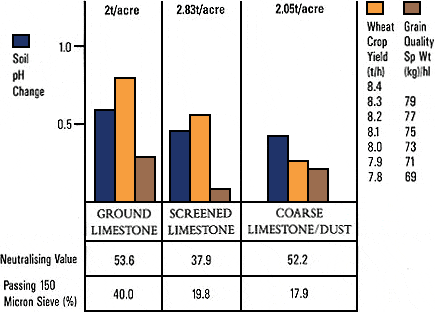|
The effectiveness of a liming material is dependent upon its neutralising value, the fineness of grinding, reactivity and the relative hardness of the parent rock.
Neutralising values
The neutralising value of a liming material is expressed in terms of the percentage of calcium oxide equivalent. Thus, 100 kg of a liming material with a neutralising value of 52% will have the same neutralising value as 52 kg of pure calcium oxide (CaO). Neutralising value is determined in the laboratory and is calculated from the results of the chemical reaction with known strength hydrochloric acid, and always refers to the sample 'as received' rather than on a dry matter basis.
Reactivity
The effectiveness and speed of reaction of a liming material can be quantified in the laboratory using the "Reactivity Test". The results obtained from this test may be used to estimate the behaviour of a liming material in the soil. These results bear a good correlation with results obtained from long term pot trials.
The Reactivity Test involves the decomposition of the liming material in hydrochloric acid under stable pH conditions. The acid consumption during a given time is a direct criterion for the reaction time of the liming material being tested. The results of the test are expressed as a percentage, and they compare the speed and effectiveness of the sample with pure precipitated calcium carbonate.
ADAS FINENESS OF GRINDING TRIALS

COARSER MATERIAL REQUIRES A HEAVIER APPLICATION
For maximum effectiveness, the harder and less porous the parent rock, the finer the liming material must be ground. An indication of the importance of the fineness of grinding can be seen from the field trial results.
These field trials were carried out over a number of years. In the short term, the effect of the finer liming materials was even more marked. Where lime is applied to an acid soil, there is a well proven relationship between the fineness of grinding and the crop yield response. There is a considerable reduction in the effectiveness of liming materials containing particles above 600 microns (0.60mm, 60 mesh) unless the material is easily broken down.
Consequently, fineness is slightly less important in respect of:
- Burnt lime which breaks down to a fine powder as a result of chemical reaction with water.
- Soft, porous chalks which break down easily in the soil from the action of frost or the passage of cultivating implements.
Neutralising value, fineness and reactivity are the three factors which influence lime quality.
Effective, economic liming will rely, not only upon the quality and suitability of the liming materials, but also upon having a soundly managed liming policy. The aim should be to maintain the lime status of the soil on a rotational basis. The cycle of the rotation will depend upon the locality, the type of soil, and the style of management. The rate of lime loss will need to be established from regular soil pH testing. Annual lime losses vary considerably over the British Isles and a liming rotation cannot be established by guesswork.
The ultimate objective is to maintain the soil for arable crops at pH 7 and pH 6.5 for grassland. (Peaty soils should be maintained at pH 6.5 and pH 6 respectively).
|



